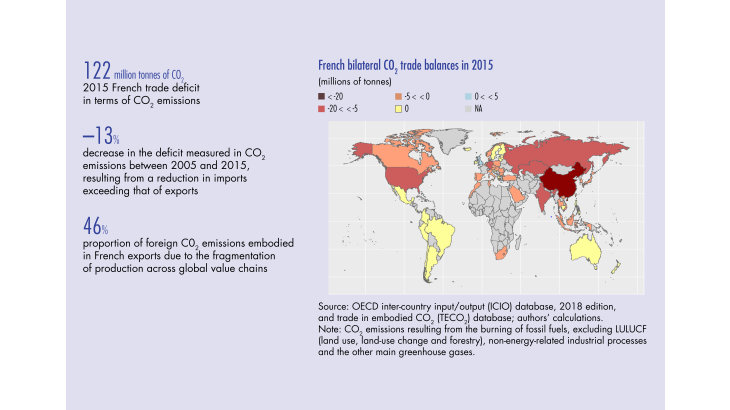The article analyses the impact of international trade on French CO2 emissions. It aims to measure all the CO2 emitted along the entire chain of production and distribution of French exports and imports. It thus complements the article “CO2 emissions embodied in international trade” (Cezar and Polge, 2020) with a country specific focus.
The fight against global warming is based on carbon dioxide (CO2) emissions as the main measurement tool. International agreements thus attempt to coordinate a collective effort to reduce these greenhouse gas emissions (United Nations, 2015). The objectives set out in such agreements target emissions within national borders (United Nations, 1992). However, this measurement does not take into account international trade and thus remains an incomplete indicator of countries’ respective impact on global CO2 emissions.
An alternative approach consists in attributing these emissions to the country in which they are consumed rather than produced. This method makes it possible to establish a country’s “carbon footprint”, i.e. the quantity of CO2 emitted to produce the goods and services consumed in the country (Davis and Caldeira, 2010). International trade serves as a link between these two measurements. Indeed, part of a country’s consumption may be imported, leading to “offshoring” of the associated emissions to their country of origin (Peters et al., 2011). Conversely, another proportion of the country’s emissions may not be consumed locally, but rather exported.
France has a CO2 trade deficit of 122 million tonnes. This means that the country consumes more CO2 than it produces, its footprint exceeding national emissions by the amount of this deficit. France’s carbon footprint was 445 million tonnes of CO2 in 2015 (OECD, trade in embodied CO2 [TECO2] database). This corresponds to the emissions produced within its borders (323 million tonnes), plus imports (236 million tonnes of CO2 emitted abroad), minus exports (115 million tonnes of CO2 emitted on French territory but subsequently consumed abroad).
This situation is due in particular to the trade balance in monetary terms, which is in deficit overall. In addition, France has a lower CO2 emission intensity compared to its partners, owing to the prevalence of CO2 efficient nuclear power in the French energy mix (IPCC, 2018). Moreover, the trade structure also plays a role: value added from the service sector, which emits very little, accounts for nearly two thirds of French exports (Cezar, 2016).
France thus maintains a “carbon” deficit with almost all of the countries in the sample…
[to read more, please download the article]
